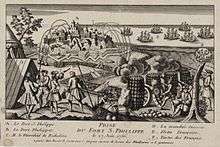William Blakeney, 1st Baron Blakeney

Lieutenant-General William Blakeney, 1st Baron Blakeney KB (1671/1672 – 10 September 1761) was an Irish soldier known for his unsuccessful defence of the Spanish island of Minorca following the Battle of Minorca in 1756.
Early life
Blakeney was born at Mount Blakeney, County Limerick, to William Blakeley (MP) in the Irish House of Commons for Kilmallock, and Elizabeth (née Bowerman).[1]
Destined for politics, he showed a decided preference for a military career. At age 18, he headed the tenants in defending the Blakeney estate against the Rapparees. As a volunteer he fought the war in Flanders, and at the Siege of Venlo in 1702 won his commission. He served as a subaltern throughout Marlborough's campaigns, and is said to have been the first to drill troops by signal of drum or colour. Between 1725 and 1757, he represented Kilmallock in the Irish House of Commons. [2]
For many years after the peace of Utrecht he served unnoticed, and was 65 years of age before he became a colonel. This neglect, which was said to be due to the hostility of Lord Verney, ceased when the Duke of Richmond was appointed colonel of Blakeney's regiment, and thenceforward his advance was rapid. Brigadier-general in the Cartagena expedition of 1741, and major-general a little later, he distinguished himself by his gallant and successful defence of Stirling Castle against the Highlanders in 1745. Two years later George II made him lieutenant-general and lieutenant-governor of Minorca.[2]
Fall of Minorca

The governor of that island never set foot in it, and Blakeney was left in command for ten years. In 1756 the Seven Years' War was preluded by a swift descent of the French on Minorca. Fifteen thousand troops under marshal the duc de Richelieu, escorted by a strong squadron under the marquis de la Gallisonnière, landed on the island on 18 April, and at once began the Siege of Fort St. Philip (1756), where Blakeney commanded at most some 5,000 soldiers and workmen.[2]
The defence, in spite of crumbling walls and rotted gun platforms, had already lasted a month when a weak, undersupplied British fleet under vice-admiral John Byng appeared.[2] La Gallisonnière and Byng fought, on 20 May, an indecisive battle. Byng left Blakeney to his fate since his fleet received losses of over 400 men. Damaged ships necessitated that Byng sail for the nearest port repair facilities in the Mediterranean, that being Gibraltar, where Byng hoped to repair his fleet for a return. A second expedition subsequently appeared off Minorca, but it was then too late, for after a heroic resistance of seventy-one days the old general had been compelled to surrender the fort to Richelieu (18 April – 28 June 1756). Only the ruined fortifications were the prize of the victors. Blakeney and his little garrison were transported to Gibraltar with absolute liberty to serve again. Byng was tried and executed; Blakeney, on his return to England, found himself the hero of the nation.[2][3]
Later life
He was made a Colonel of the 27th (Inniskilling) Regiment of Foot, a Knight Companion of the Bath, and Baron Blakeney in the Irish peerage.[4] Later, John Van Nost the Younger's statue of him was erected in Dublin (on the site of the present-day Spire of Dublin), and his popularity continued unabated for the short remainder of his life. He died unmarried on 10 September 1761, and was buried in Westminster Abbey.[2] The barony became extinct upon his death.[5]
See also
References
- ↑ Profile at thepeerage.com for Lt.-Gen. William Blakeney, 1st and last Baron Blakeney of Castle Blakeney
- 1 2 3 4 5 6
 One or more of the preceding sentences incorporates text from a publication now in the public domain: Chisholm, Hugh, ed. (1911). "Blakeney, William Blakeney". Encyclopædia Britannica. 4 (11th ed.). Cambridge University Press. p. 38. This cites Memoirs of General William Blakeney (1757).
One or more of the preceding sentences incorporates text from a publication now in the public domain: Chisholm, Hugh, ed. (1911). "Blakeney, William Blakeney". Encyclopædia Britannica. 4 (11th ed.). Cambridge University Press. p. 38. This cites Memoirs of General William Blakeney (1757). - ↑ At 12, Mr. Byng Was Shot. Phoenix; First Edition (1 October 2002), 352 pages; ISBN 1842126075/ISBN 978-1842126073 by Dudley Pope
- ↑ The London Gazette: no. 9642. p. 1. 7 December 1756.
- ↑ See Memoirs of General William Blakeney (1757).
Sources
 Stephens, Henry Morse (1886). "Blakeney, William". In Stephen, Leslie. Dictionary of National Biography. 5. London: Smith, Elder & Co.
Stephens, Henry Morse (1886). "Blakeney, William". In Stephen, Leslie. Dictionary of National Biography. 5. London: Smith, Elder & Co. - Blakeney, William, Baron Blakeney (1671/2–1761) in the Oxford Dictionary of National Biography: doi:10.1093/ref:odnb/2591
External links
| Parliament of Ireland | ||
|---|---|---|
| Preceded by Kilner Brasier John Croker |
Member of Parliament for Kilmallock 1725–1757 With: John Croker 1725–1727 Robert Oliver 1727–1739 Robert Oliver 1739–1745 Philip Oliver 1745–1757 |
Succeeded by Silver Oliver Philip Oliver |
| Military offices | ||
| Preceded by Archibald Hamilton |
Colonel of the 27th Regiment of Foot 1737–1761 |
Succeeded by Hugh Warburton |
| Peerage of Ireland | ||
| New creation | Baron Blakeney 1756–1761 |
Extinct |